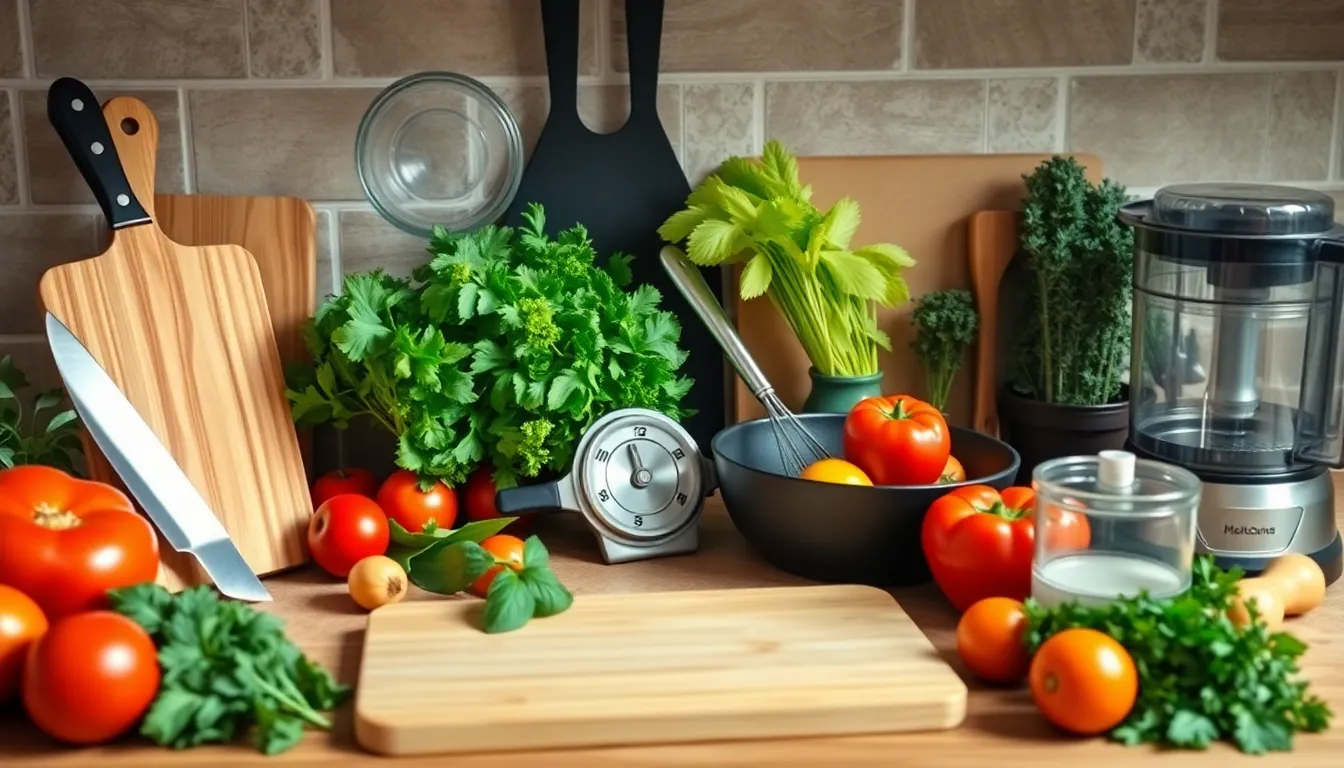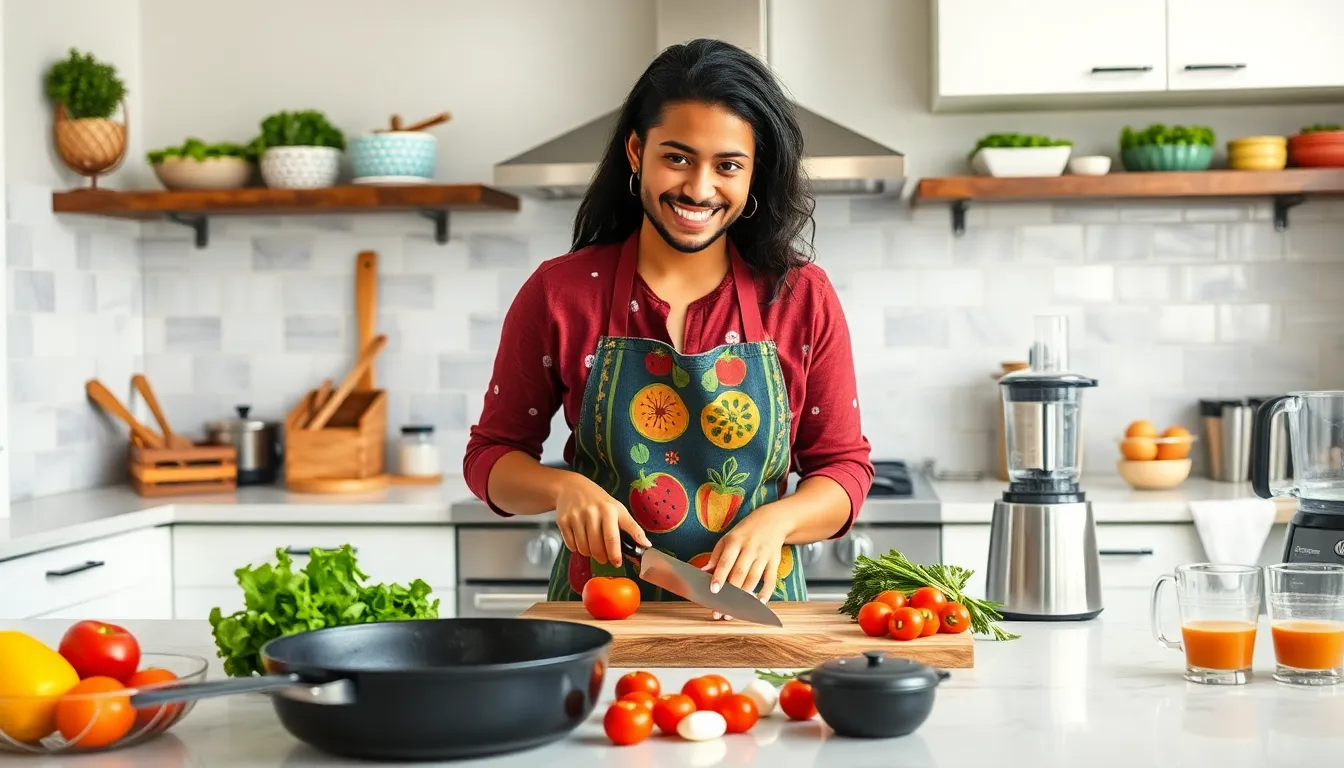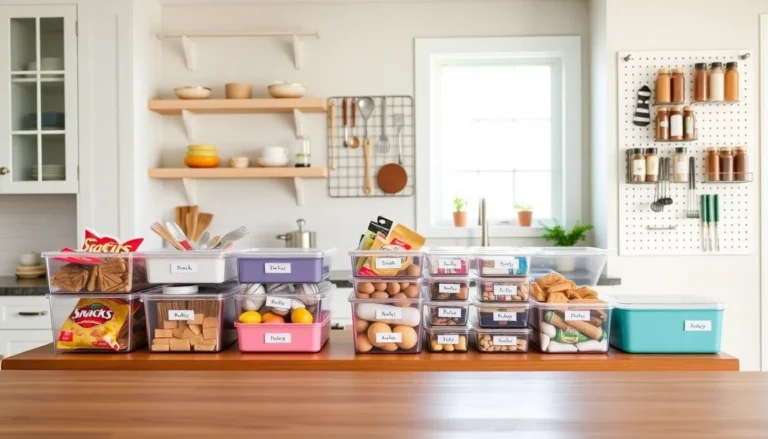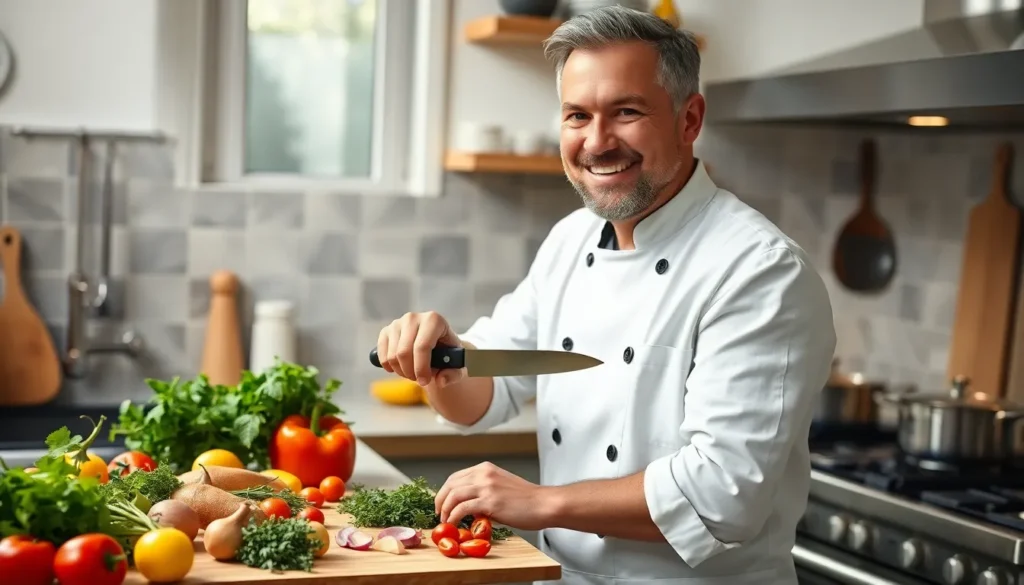Table of Contents
ToggleEvery home cook dreams of creating restaurant-quality meals without the hassle. With a few insider tips and tricks, anyone can elevate their culinary game. Whether it’s mastering the perfect sear on a steak or knowing how to balance flavors, these home chef secrets can transform the ordinary into the extraordinary.
Unlocking the potential of everyday ingredients and tools is key to achieving that sought-after gourmet experience. From simple techniques to clever hacks, these insights will not only save time but also impress family and friends. Discover how to unleash creativity in the kitchen and turn cooking into a delightful adventure.
Home Chef Secrets: Unlocking Culinary Success
Home chefs can enhance their culinary skills with key techniques and principles. Mastering the following secrets leads to restaurant-quality dishes at home.
Ingredient Quality
Selecting fresh ingredients makes a significant difference. Choose seasonal produce, which offers better flavor and nutrition. Opt for high-quality proteins, such as grass-fed beef or wild-caught fish, to elevate dishes.
Flavor Building
Building layers of flavor transforms meals. Start by sautéing aromatics like garlic, onions, or shallots. Incorporate herbs and spices at various stages to deepen taste profiles. Use acids, such as lemon juice or vinegar, to brighten flavors.
Cooking Techniques
Understanding core cooking techniques is essential. Practice methods like blanching, roasting, and braising to achieve desirable textures. Utilize high heat for searing proteins, which develops a rich crust. Embrace sous-vide cooking for precision with consistent results.
Equipment Utilization
Using the right tools enhances culinary performance. Invest in essential equipment, such as a chef’s knife, cutting board, and non-stick pans. Leverage small gadgets like immersion blenders for soups and food processors for quick prep.
Plating for Presentation
Good presentation elevates a dish. Focus on color contrast and arrangement for visual appeal. Use garnishes like microgreens or edible flowers to add vibrancy. Proper plating techniques make meals more inviting.
Time-Saving Techniques
Implementing efficient cooking strategies saves time. Prepare ingredients in advance, such as chopping vegetables or marinating proteins. Utilize one-pot recipes to minimize cleanup and maximize flavor.
Experimentation and Adaptation
Encouraging experimentation breeds creativity. Alter recipes by substituting ingredients or adjusting herbs and spices. Exploring new cooking styles keeps the process exciting and fresh.
By applying these home chef secrets, individuals can unlock culinary success and create delightful, high-quality meals with confidence.
Essential Tools Every Home Chef Needs


Equipping a kitchen with the right tools enhances both efficiency and culinary creativity. Essential utensils and gadgets simplify daily cooking tasks, enabling chefs to focus on flavor and presentation.
Kitchen Must-Haves
- Chef’s Knife: A high-quality chef’s knife is crucial for precision cutting. It allows for quick dicing, slicing, and chopping of various ingredients.
- Cutting Board: A sturdy cutting board provides a safe and hygienic surface for food preparation. Opt for a non-slip option to prevent accidents.
- Cast Iron Skillet: This versatile skillet excels at searing and retains heat effectively. It’s suitable for both stovetop and oven use.
- Guitar Peeler: This tool simplifies peeling fruits and vegetables, offering control to prevent waste and ensure even results.
- Measuring Cups and Spoons: Accurate measurements are vital for recipe success. Use both dry and liquid measuring tools for optimal results.
- Whisk: A whisk helps blend ingredients smoothly, essential for sauces, dressings, and batters.
- Mixing Bowls: A set of mixing bowls in varying sizes provides the flexibility needed for different tasks, from mixing ingredients to serving.
- Colander: This tool aids in draining pasta and washing vegetables. A good colander prevents accidents while ensuring food safety.
Time-Saving Gadgets
- Food Processor: A food processor drastically cuts down prep time by chopping, slicing, and pureeing ingredients quickly.
- Instant Pot: This multi-cooker can pressure cook, slow cook, and steam, allowing for expedited meal preparations while preserving flavor.
- Mandoline Slicer: A mandoline ensures uniform slices of fruits and vegetables, making dishes look professional and cooking more efficient.
- Immersion Blender: This handheld blender facilitates quick pureeing of soups and sauces without the need for transferring to a traditional blender.
- Electric Kettle: Boiling water becomes effortless with an electric kettle, perfect for recipes requiring hot liquids or quick tea and coffee preparation.
- Digital Meat Thermometer: This device takes the guesswork out of cooking proteins, ensuring they reach the ideal internal temperature for safety and quality.
- Slow Cooker: A slow cooker enables the preparation of meals with minimal effort. Simply add ingredients, set the timer, and let it cook throughout the day.
- Silicone Baking Mats: These mats reduce the need for parchment paper and promote easier clean-up, enhancing the baking experience.
Using these essential tools and time-saving gadgets, home chefs can streamline their cooking processes and create meals with confidence.
Mastering Flavor with Seasoning Techniques
Mastering flavor through effective seasoning techniques significantly elevates home-cooked meals. Seasoning involves balancing, enhancing, and complementing the natural flavors of ingredients.
The Art of Balancing Flavors
Balancing flavors requires an understanding of five key components: sweetness, sourness, saltiness, bitterness, and umami.
- Sweetness: Use honey, sugar, or fruits to counteract acidic or bitter flavors. For example, adding a touch of sugar to tomato-based sauces can neutralize acidity.
- Sourness: Incorporate acidic ingredients like lemon juice or vinegar to enhance depth. A splash of vinegar in a rich stew lifts the overall flavor.
- Saltiness: Utilize salt not just for flavor but also to amplify other tastes. A pinch of salt in sweet dishes can enhance sweetness.
- Bitterness: Balance bitterness from greens like kale with sweetness or acidity. Lemon juice drizzled over kale salads reduces bitterness.
- Umami: Enhance the savory quality of dishes by including ingredients high in umami, such as mushrooms, tomatoes, or parmesan cheese. Adding a few anchovies to sauces enriches umami.
Mastering these elements enables cooks to adjust flavors skillfully, creating well-rounded dishes.
Fresh Herbs vs. Dried Spices
Understanding the differences between fresh herbs and dried spices plays a crucial role in seasoning.
- Fresh Herbs: Fresh herbs, like basil or cilantro, contribute vibrant flavors and bright aromas. They work best when added at the end of cooking to maintain their potency.
- Dried Spices: Dried spices, such as oregano or cumin, release flavors slowly over time. Adding them early in the cooking process allows their flavors to infuse into sauces or stews.
- Proportion: Use one teaspoon of dried herbs for every tablespoon of fresh herbs. This ratio ensures flavor balance in recipes.
- Storage and Longevity: Store dried spices in a cool, dark place to preserve their potency. Fresh herbs should be stored in the refrigerator, wrapped in a damp paper towel, to extend freshness.
- Flavor Profiles: Recognize that each herb and spice adds unique notes to dishes. Experiment with combinations to discover new flavor dimensions.
Incorporating these seasoning techniques enhances culinary creations, transforming everyday meals into extraordinary dining experiences.
Meal Prep Strategies for Home Chefs
Meal prep strategies can enhance efficiency for home chefs, making weeknight dinners easier and more enjoyable. Implementing effective planning and organizing methods streamlines the cooking process and saves time.
Planning and Organizing Meals
Planning meals involves creating a weekly menu and shopping list. This method ensures that home chefs select seasonal and fresh ingredients. They can categorize ingredients by type, such as proteins, vegetables, and grains, to simplify grocery shopping. Organizing food items in the pantry and refrigerator promotes easy access and reduces waste.
Utilizing meal planning apps or printable templates helps visualize the week’s menu. Scheduling prep days allows for batch cooking, which can lead to multiple meals ready to reheat. Creating a rotation of favorite recipes ensures variety while limiting the burden of decision-making.
Efficient Cooking Methods
Efficient cooking methods reduce prep time and enhance flavor. One-pot dishes, sheet pan meals, and slow-cooked recipes maximize flavors while minimizing cleanup. Using a pressure cooker, like an Instant Pot, cooks meals quickly without sacrificing taste.
Employing techniques such as blanching allows vegetables to cook evenly while retaining their vibrant colors. Cooking larger portions of staples, like rice or quinoa, saves time on busy days.
Incorporating sous-vide techniques provides precise cooking results, ensuring proteins remain tender and juicy. Preparing ingredients in advance, such as chopping vegetables or marinating proteins, significantly cuts down on cooking time during busy weekdays.
By combining planning and efficient cooking methods, home chefs can transform meal preparation into a streamlined process, allowing for delicious, hassle-free dinners throughout the week.
Creative Presentation Tips
Creative presentation transforms meals into visually appealing experiences that enhance enjoyment. Here are several effective strategies for elevating dish presentation:
- Use Color Contrast: Incorporate various colored ingredients. Bright vegetables, fresh herbs, and vibrant sauces create visual interest. For example, a green herb sauce over a golden roasted chicken adds depth.
- Play with Shapes: Present food in diverse shapes and sizes. Use cookie cutters for fruits or vegetables to create uniform shapes, adding a playful element. Arrange slices of different thicknesses for texture variety.
- Layer Ingredients: Stack components for height and dimension. Layering ingredients, like quinoa, grilled vegetables, and protein, creates visual appeal while showcasing flavors. Use a clear glass for salads to highlight each layer’s colors and textures.
- Incorporate Garnishes: Use fresh herbs, edible flowers, or microgreens as final touches. These elements add vibrant colors and fresh flavors. A sprinkle of sesame seeds on a stir-fry or a basil leaf on pasta can elevate dishes.
- Choose Unique Serving Ware: Select distinctive plates or bowls to enhance presentation. Slate tiles, wooden boards, or oversized bowls create a unique dining experience. Use contrasting colors to highlight the food.
- Create Height Variation: Utilize elevated platters or risers to add levels. Displaying appetizers on different heights allows for engaging visuals. Stacking a tower of pancakes showcases the dish’s variety and invites diners in.
- Experiment with Patterns: Arrange food in artistic patterns on plates. For example, a swirl of sauce around a dish or a geometric design with vegetables creates intrigue. Patterned plating delivers an artistic presentation.
- Mind the Negative Space: Use the empty space on the plate to draw attention to the food. A clean plate with a strategic arrangement enhances focus. An aromatic herb garnish adds color without cluttering the presentation.
- Utilize Drizzling Techniques: Drizzle sauces or oils artistically over food. A light drizzle of balsamic glaze on a caprese salad can create a gourmet look. Use a squeeze bottle for precision in design.
By applying these creative presentation tips, home cooks can impress family and friends, elevating the dining experience beyond just taste.
Embracing these home chef secrets can truly transform the culinary experience. By focusing on techniques and flavor mastery home cooks can elevate their dishes to new heights. The right tools and ingredients play a crucial role in achieving restaurant-quality meals at home.
Creative presentation and efficient meal prep strategies not only enhance the visual appeal but also simplify the cooking process. With a bit of experimentation and confidence in the kitchen anyone can turn everyday cooking into a delightful adventure.
So it’s time to unleash creativity and enjoy the journey of cooking delicious meals that impress family and friends alike.







